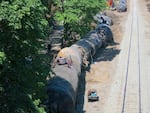
A 16-car oil train derailment caused a fire and left a small oil sheen on the Columbia River.
Conrad Wilson / OPB
Railroad industry experts are questioning the early explanation from Union Pacific for why its oil train crashed in Mosier, Ore.
Union Pacific said the preliminary indications from its investigation are “the failure of a fastener that connects the rail to the railroad tie,” according Justin Jacobs, a railroad spokesman.
The 96-car Union Pacific train was carrying Bakken crude oil to a refinery in Tacoma, Wash., when it had an “undesired emergency application” of its brakes. Sixteen tanker cars derailed in Mosier, resulting in a fire and an estimated 42,000 gallons of spilled oil.
Multiple railroad industry experts have said they find it unlikely a fastener failure could cause a derailment of that size.
“The failure of one fastener generally would not lead to a derailment like this,” said Rick Inclima, safety director for the Brotherhood of Maintenance of Way Employees — the labor union representing railroad track inspectors and maintenance workers.
Inclima called the preliminary explanation “perplexing.” He said multiple fasteners would have to fail to cause a derailment of that size.
Thomas Frederick, a union officer in Seattle and locomotive engineer for the past 27 years, also said it sounded implausible.
“I would say that one rail fastener could be a contributing factor. But it’s got to be more than just that,” Frederick said.
Representatives from Union Pacific and the Federal Railroad Administration are still investigating the cause of the derailment.
Union Pacific said the track in question was previously replaced in 2013 and was inspected twice weekly.
According to the railroad, it had been inspected using technology to detect internal rail defects and geometry problems, as well as visually inspected for defects as recently as May 31, four days before the derailment.
Those inspections did not turn up any issues with the track.
